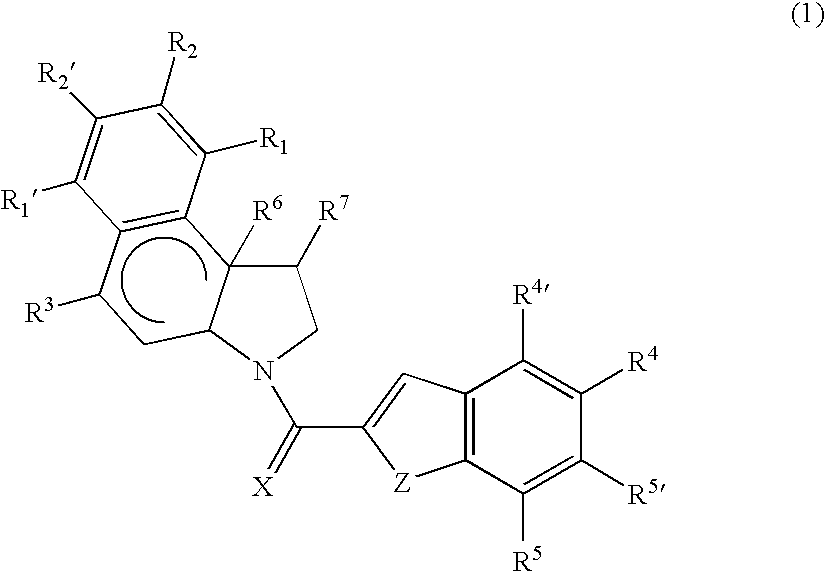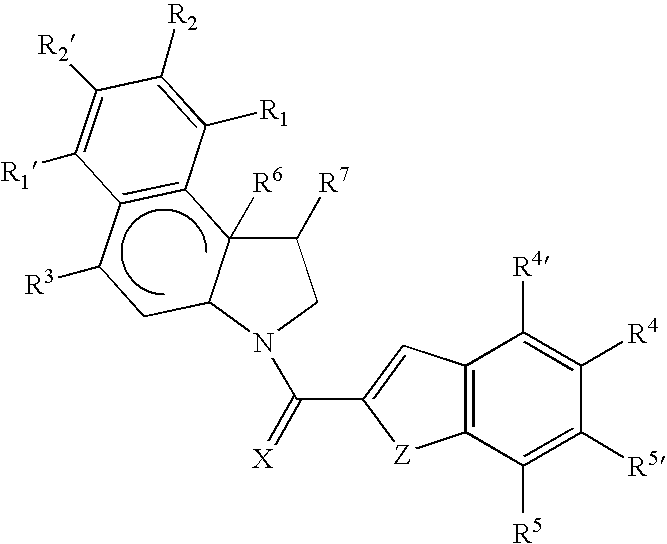Cytotoxic compounds and conjugates with cleavable substrates
a technology of cytotoxic compounds and conjugates, applied in the field of cytotoxic compounds, can solve the problems of limiting application, affecting the stability of plasma, and often exhibiting acute toxicity in vivo,
- Summary
- Abstract
- Description
- Claims
- Application Information
AI Technical Summary
Benefits of technology
Problems solved by technology
Method used
Image
Examples
example 1
[0242]
[0243] Synthesis of Compound 32. To a solution of Compound 30 (120 mg, 0.28 mmole) in ethyl acetate (10 mL) was bubbled HCl gas for 5 min. The reaction mixture was stirred at RT for another 30 min and then the mixture was concentrated. Ether was added to the reaction mixture and the white precipitate was collected on a filter funnel. Solid was dried overnight under vacuum to give 100 mg of the desired product which was confirmed by LC-MS (ESI) 324 (M+H+) and used in next step without further purification. To a solution of this compound (100 mg, 0.24 mmole) in DMF (5 mL) were added compound 31 (65 mg, 0.26 mmole), HATU (100 mg, 0.26 mmole) and TEA (91 uL, 0.52 mmole). The mixture thus obtained was stirred at room temperature for 3 hrs. The solvent was evaporated and the residue was purified on semi-preparative HPLC with 0.1% TFA in water and acetonitrile as eluent to give compound 32 as an oil (110 mg, 80%). The desired product was confirmed by LC-MS (ESI) 555 (M+H+).
[0244] Sy...
example 2
[0246]
[0247] Synthesis of Compound 1 Cephalotin Sodium salt (0.5 g, 1.2 mmole) was dissolved in water (10 mL) ansd poured into a separative funnel. The solution was acidified with IN HCl aqueous solution and the desired compound was extracted with Dichloromethane (100 mL) and Ethyl Acetate (40 mL). The organic layer was dried over Na2SO4 anhydrous, filtered and concentrated to dryness to give the title compound as a white solid (474 mg, 99%). To a solution of the white compound (1.2 mmole) and tert-Boc2O (0.3 g, 1.37 mmole) in Tetrahydrofuran (20 mL) was added Dimethylaminopyridine (15 mg, 0.12 mmole). The mixture thus obtained was stirred at room temperature overnight. The solvent was evaporated and the residue was purified on semi-preparative HPLC with 0.1% TFA in Water and Acetonitrile as eluent to give the title compound as an oil (238 mg, 44%). 1H NMR (CD3OD) δ 1.49 (s, 9H), 2.05 (s, 3H), 3.80 (s, 2H), 4.60 (d, 1H), 4.77 (d, 1H), 4.93 (d, 1H), 5.28 (d, 1H), 5.49 (m, 1H), 6.59 (...
example 3
[0253]
[0254] Synthesis of compound 2. In a 50 ml round bottom flask equipped with stir bar and nitrogen inlet, Fmoc-βAlaLeuAlaLeu-OH (5 gm, 0.0082 moles, Abbott Labs) was dissolved in DMF (30 ml). HATU (3.13 gm, 0.0082 moles) then DIPEA (2.86 ml, 0.0164 moles) were added and the solution stirred for 10 minutes. 4-Aminobenzyl alcohol (1.5 gm, 0.0122 moles) was added and the reaction stirred at room temperature for 18 hrs. The solvent was concentrated in vacuo and the residue dissolved in DMF (20 ml). The product was precipitated with diethyl ether (200 ml) and collected by filtration to give 4.5 gm (77%) of product. The product was confirmed by mass 10 spec: m / z 714.4 [M+1]+
[0255] Syntheis of compound 3. In a 25 ml RBF equipped with stir bar and nitrogen inlet, 2 (0.3 gm, 0.4 mmoles) was dissolved in 1.5 ml DMF. A 1:1 solution of DCM / THF was added followed by 4-nitrophenylchloroformate (0.2 gm, 1 mmole) and pyridine (0.2 ml, 2.5 mmoles). The reaction 15 was stirred at room temperatur...
PUM
| Property | Measurement | Unit |
|---|---|---|
| temperature | aaaaa | aaaaa |
| pressure | aaaaa | aaaaa |
| flow rate | aaaaa | aaaaa |
Abstract
Description
Claims
Application Information
 Login to View More
Login to View More - R&D
- Intellectual Property
- Life Sciences
- Materials
- Tech Scout
- Unparalleled Data Quality
- Higher Quality Content
- 60% Fewer Hallucinations
Browse by: Latest US Patents, China's latest patents, Technical Efficacy Thesaurus, Application Domain, Technology Topic, Popular Technical Reports.
© 2025 PatSnap. All rights reserved.Legal|Privacy policy|Modern Slavery Act Transparency Statement|Sitemap|About US| Contact US: help@patsnap.com



